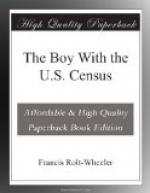“Even the head-hunters?”
“Certainly. There are Filipinos of two grades,—apparently of two periods of migration. The first came and settled the islands away a long time back, driving the Pygmies to the forests, and occupying the coasts themselves. These tribes, the Igorots, the Ilongots, the Bilans, and so forth, are of the same general type as the head-hunters of Borneo, and some,—like the Ilongots—to this day carry out the savage custom that ’no young man can be accepted in marriage until he has presented his bride with a human head.’”
“That is certainly savage,” Hamilton agreed; “one never thinks that sort of thing can be going on still, and certainly not under the American flag!”
“It is, though,” the Porto Rican replied. “The third group,” he continued, “the Moros and so forth, are all Mohammedans, and they seem to have come to the islands after the semi-civilization of the Malay archipelago and its submission to Mohammedanism. The Moros are haughty and assume the air of conquerors. As the Igorots drove the Negritos to the forest and thence to the wild interior, so the Moros drove the Igorots. They are largely pure Malay, warlike and cruel, but shrewd and capable of culture. They assume an over-lordship over all other tribes and their Dattos can generally enforce it.”
“It seems strange,” the boy said, “to think of going among those savages and asking them the same questions that United States citizens were asked, writing the answers on the same kind of schedules, and counting these ferocious head-hunters on a tabulating machine.”
“Of course,” the editor reminded him, “the Philippine census last time was taken by the War Department, although the Bureau is even now considering what will be the best way to attack the problem should it have to take the next Philippine census, as it probably will. But while it was primitive, the work wasn’t so very different. They were able to use advance schedules, for example.”
The boy stared, and his informant laughed outright.
“They were a little different,” he explained, “and it was during the enumeration of the Igorots and similar tribes. It was soon found that they could count up to ten but no further. A certain number of them could grasp the idea of ten groups of ten. So a bundle of sticks was sent to each village and each man was made to cut notches in these sticks up to ten to show how many children, or pigs, or chickens he had. In some of the villages so my uncle told me, the supervisor had a branding iron made with which he had branded on the tally sticks the figure of a pig, or a house, or a chicken or whatever it might be.”
“That is about as far back, I should think, as any one could go, in the way of census-taking,” the boy said. “I thought some of my up-country negro farmers were barbaric—especially when I came across some voodooism, but now I see I didn’t know what barbarism meant.”




